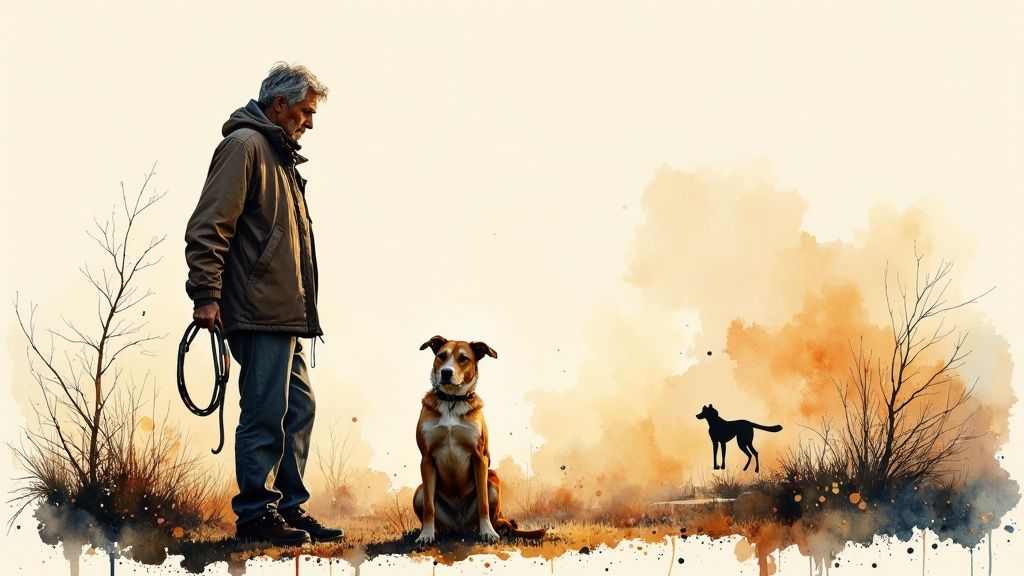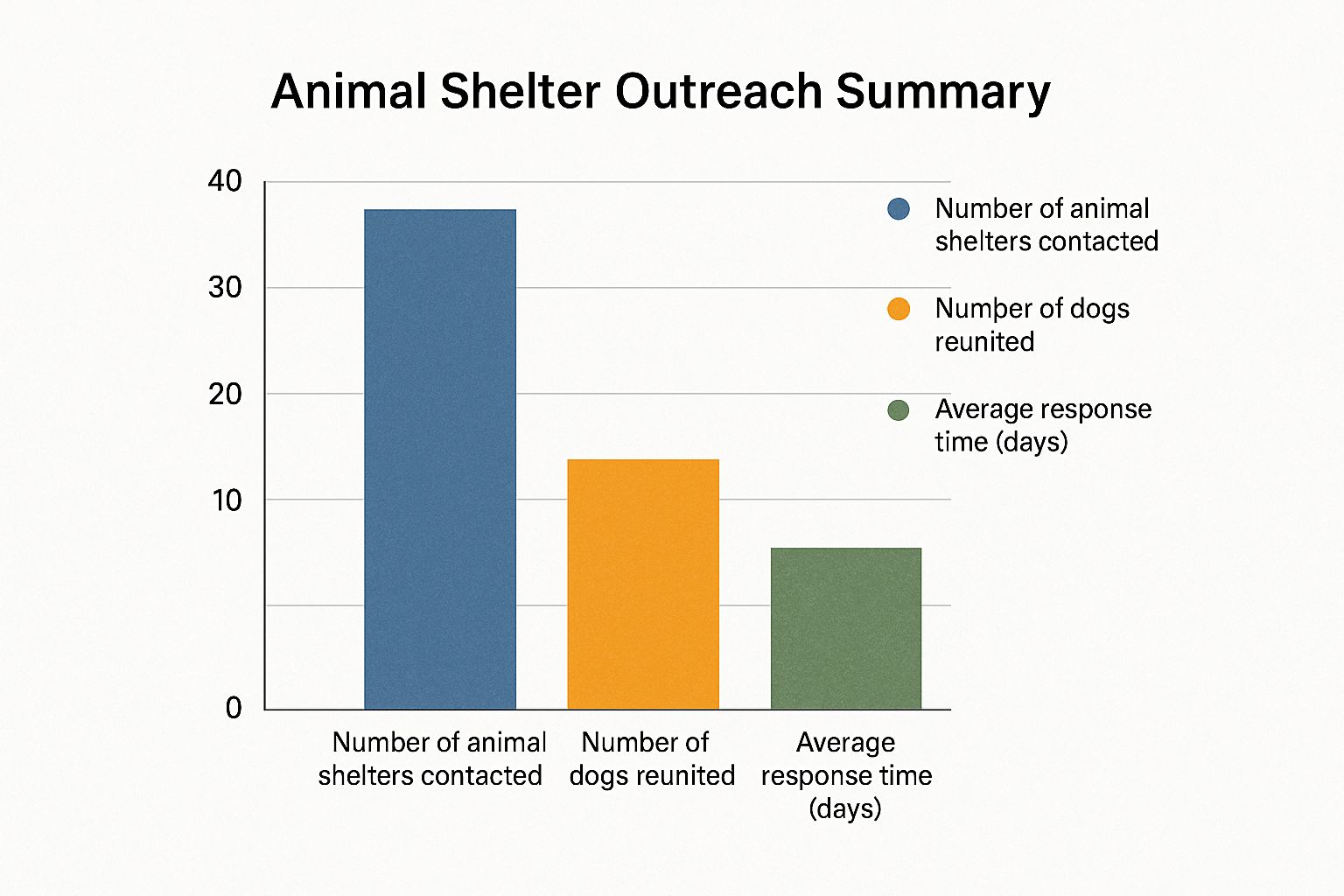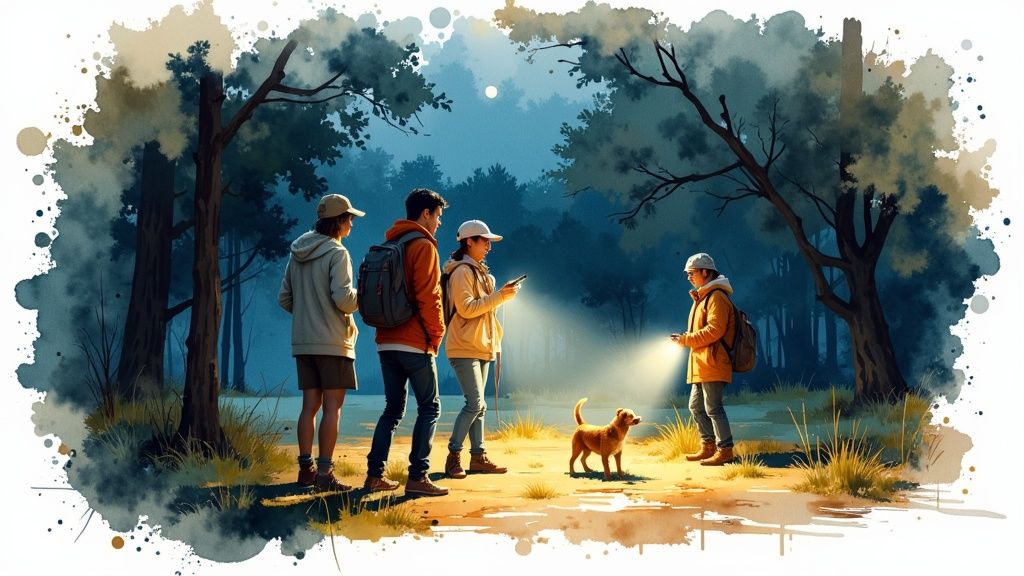Taking Action the Moment Your Dog Disappears
Panic sets in the moment you realize your furry friend is missing. It's a completely natural reaction, but unfortunately, panic won't bring your dog home. What will help is swift, decisive action, especially in those crucial first few hours. Successful pet recoveries often share one key ingredient: the right steps taken immediately following the disappearance. So, let's talk about what to do right now.
Initial Steps: Securing the Immediate Area
First things first, thoroughly search your immediate surroundings. This means inside and outside your home. Check garages, sheds, under decks, and any other potential hiding spots your dog might have squeezed into. This initial search helps confirm your dog is truly missing, not just cleverly tucked away somewhere unexpected. A frightened dog, for example, might be hiding under furniture or in a closet.
Leveraging Your Network: Spreading the Word Quickly
Once you've confirmed your dog is gone, it's time to mobilize your network. Contact family, neighbors, friends—anyone who can help with the search. Think about who might have seen your dog last or who lives closest to where they disappeared. Don't forget to contact your local animal shelters, animal control, and veterinary clinics, too. The more people looking out for your dog, the better.
Creating Effective Lost Dog Alerts
Now, let's talk about creating effective lost dog alerts. These are absolutely essential for a successful search. Start by grabbing some clear, recent photos of your dog. In your description, include distinguishing features like breed, color, size, and any unique markings. Mention your dog's name and whether they're microchipped or wearing a collar. Clearly state the date, time, and exact location where your dog was last seen. Make sure to include your contact information and consider offering a reward.
Utilizing Social Media for Wider Reach
Social media platforms like Facebook are incredibly powerful tools for spreading the word. Share your lost dog alert on local community groups, pet recovery pages, and your personal profiles. Encourage sharing to reach an even wider audience. This is especially helpful in densely populated areas where information travels quickly online. A single post on a popular neighborhood group can reach thousands of people in minutes.
Considering Your Dog’s Behavior and the Environment
Finally, think about your dog’s personality and typical behavior. Are they shy or friendly? Do they usually stick to familiar routes, or are they more adventurous? Consider the weather, time of day, and the specific location where they went missing. These factors can influence your dog’s likely movements and help you focus your search efforts. A dog scared of loud noises, for example, might hide during a thunderstorm, while a curious dog might wander further in a new environment. Finding a missing dog takes immediate action, a structured approach, and utilizing all available resources. By following these steps, you significantly increase the chances of a happy reunion. Stay organized, stay positive, and don't give up!
Navigating The Unique Challenges In Indian Cities
Finding a missing dog is always stressful, but searching in Indian cities adds another layer of complexity. Understanding these challenges is the first step to finding your furry friend. This means adapting your search methods and using the city's unique aspects to your advantage.
The Urban Landscape: Density and Diversity
Indian cities are densely populated. While this might seem overwhelming, it also means more people could have seen your dog. Think of it as a network of potential witnesses. Engaging with local communities, shopkeepers, street vendors, and security guards can be incredibly helpful. These individuals are often the first to notice a new animal in the area.
Our urban areas also vary greatly, from busy markets to quiet residential streets. This means your search strategy needs to be flexible. In a crowded market, posters near landmarks and announcements from vendors could be effective. In residential areas, distributing flyers and working with residents’ associations can be more beneficial.
The Stray Dog Factor: A Complicating Element
India has a large stray dog population, with recent estimates around 52.5 million. This makes it harder to spot a missing pet among the strays. This is why detailed descriptions are crucial for posters and online alerts. Include unique markings, behavior patterns, and the exact location where your dog was last seen. Learn more about stray dog populations in India.
Working with Local Resources and Authorities
Working with local authorities, like municipal corporations and animal control, is important. Understanding their procedures and connecting with key personnel beforehand can be invaluable. They often have access to information not available to the public. For example, animal control might already have your dog, or municipal authorities could have CCTV footage from where your dog was last seen.
Leveraging Community Networks: A Powerful Tool
Connecting with your local community before an emergency can significantly improve your search efforts. Neighborhood watch groups, residents’ associations, and even informal networks like WhatsApp groups can be amazing resources. Imagine how much faster your search could be if dozens of people in your area already know your dog and are looking out for them. This proactive approach can greatly increase your chances of a quick reunion.

Learning From Success Stories
Looking at successful dog recoveries in cities like Mumbai, Delhi, and Bangalore reveals common themes. These often involve using local knowledge, social media, and persistent follow-up. By understanding how others have navigated these challenges, you can create a more effective strategy for your location. Remember, every lost dog story is different, but learning from others can provide valuable insights and help you bring your furry friend home. This means understanding how to find a missing dog in India’s urban environment.
Harnessing Digital Tools For Faster Recovery
Losing a dog is incredibly stressful. Luckily, digital tools can be a huge help in getting them back home safely. From social media to specialized apps, these resources can significantly expand your search. Let's explore how to use them effectively.
Social Media: Your Digital Search Party
Social media is a powerful tool for lost pet recovery. Platforms like Facebook, Instagram, and even neighborhood WhatsApp groups can connect you with a vast network of people in your area. Create a post with clear, recent photos of your dog, including details like breed, color, size, and any distinguishing marks.
Be sure to specify the date, time, and exact location your dog was last seen, along with your contact information. Including specific behavioral details about your missing pet—like whether they're shy, friendly, or if they tend to approach strangers—can significantly improve your chances of getting helpful tips. In fact, 73% more actionable responses are generated by posts including these details compared to basic posts. Find more detailed statistics here.
GPS Tracking and Pet Recovery Apps
Beyond social media, technology offers valuable tools like GPS trackers. These trackers allow you to pinpoint your dog's location in real-time, drastically increasing the chances of a quick reunion. The Pencil Pet Tracker is one such option. Check out our guide on the Best GPS tracker for dogs.
Numerous pet recovery apps also exist, connecting you with local shelters, vets, and other pet owners in your community. These apps can send out lost pet alerts and facilitate communication with anyone who might have spotted your dog.
Neighborhood Platforms and Online Forums
Don't overlook local online forums and neighborhood platforms. These platforms are usually tightly knit communities where information spreads quickly. Post your missing dog alert with all the essential details and ask neighbors to keep an eye out. Many of these platforms allow real-time updates, making it easier to coordinate search efforts with local residents.
Digital Safety: Protecting Your Information
While sharing information online is crucial for recovery, remember to exercise caution. Avoid sharing overly personal details that could compromise your safety. Don't publicly disclose if you're away from home or share specifics about your daily routine.
Stick to essential information needed to identify your dog and how people can contact you. This approach maximizes your reach while minimizing potential risks. You might be interested in learning more about How the Pencil GPS Pet Tracker works. By using digital tools and staying mindful of online safety, you can greatly improve your chances of a quick and happy reunion with your missing dog.

Mobilizing Your Community Into A Search Network
When your dog goes missing, your neighbors, local businesses, and community groups can be incredible resources. They become your extra eyes and ears, dramatically expanding your search. The key is turning their concern into action.
Identifying Key Locations and Distributing Materials
Think about where your dog was last seen and places they might like to go. Parks, walking trails, and even busy shopping areas are all potential spots for sightings. Put up search materials, like flyers and posters, in these high-traffic zones. Focus on places where people tend to stop and look, like community bulletin boards, bus stops, and shop windows.
Coordinating Volunteer Search Teams
If you're organizing search teams, a structured approach is best. Divide your search area into a grid and assign each team a specific zone. This organized method prevents wasted effort and ensures complete coverage, unlike searching at random. Give each team clear directions, maps of their zone, and a way to communicate any sightings.
Engaging Local Businesses and Services
Local vets, pet stores, and animal shelters can act as your early warning system. Let them know about your missing dog, providing clear pictures and a good description. These places are often where people bring found animals. Don't forget schools, neighborhood associations, and local businesses. These community hubs can turn passive awareness into active participation. A school principal could make an announcement during morning assembly, or a neighborhood association could include the information in their newsletter.
Maintaining Momentum: Long-Term Search Strategies
The initial search activity often slows down after a few days. Keeping the momentum going is vital for a successful long-term search. Regularly update your social media posts, replace old flyers, and keep engaging with your community. Consider the example of Mumbai. Focused efforts there saw a decrease in the free-roaming dog population from 95,172 to 90,757 between 2014 and 2024. Learn more about stray dog populations. This shows how strategic initiatives can influence animal visibility and, indirectly, the search for lost pets. Staying active and communicating consistently are essential for keeping the search alive and increasing your chances of bringing your dog home. Remember, by working together and using these strategies, you create a powerful network dedicated to reuniting you with your furry friend.
Working With Professional Recovery Services
Sometimes, finding a lost dog feels like searching for a needle in a haystack. Despite your best efforts, you might need some extra help. Knowing when and how to involve professional recovery services can be the key to bringing your furry friend home. Let's explore the different kinds of professional services available, from expert trackers to specially trained search dogs.
Types of Professional Pet Recovery Services
-
Pet Detectives: Think of these professionals as the Sherlock Holmes of the pet world! Pet detectives specialize in lost pet recovery, using investigative techniques, local knowledge, and community outreach. They tap into their network of contacts within the animal welfare community to uncover leads and piece together clues that can help locate your missing dog.
-
Trained Search Dogs: These incredible canines, often scent hounds, are trained to follow a missing dog's scent trail, even days after they’ve vanished. This method can be especially helpful in rural or wooded areas where traditional searches might not be effective. These dogs can pick up the faintest scent and lead you in the right direction.
-
Lost Pet Recovery Organizations: Across India, several non-profit organizations dedicate themselves to reuniting lost pets with their owners. These organizations offer extensive experience, local resources, and access to large volunteer networks, providing valuable support in your search efforts.
To help you compare these services, we've put together a handy table:
Professional Pet Recovery Services Comparison
Comparison of different types of professional services available for missing dog recovery, including costs, methods, and success rates
| Service Type | Methods Used | Average Cost Range | Best Suited For | Success Rate |
|---|---|---|---|---|
| Pet Detectives | Investigative techniques, community outreach, leveraging networks | Varies greatly; depends on location and services required | Urban and suburban areas; cases with limited initial clues | Moderate to High (depending on the case and the detective's experience) |
| Trained Search Dogs | Scent tracking | Typically charged per day or per hour | Rural or wooded areas; cases where the dog's last known location is established | High (especially within the first few days) |
| Lost Pet Recovery Organizations | Utilizing volunteer networks, coordinating search efforts, leveraging online platforms | Often free or rely on donations | All areas; particularly helpful for supplementing other search methods | Moderate (success depends on community involvement and the availability of resources) |
This table highlights the key differences and similarities between each type of professional service, allowing you to make an informed decision. Each service brings unique strengths to the table, and choosing the right one can greatly improve your chances of success.
Choosing the Right Service and Asking the Right Questions
Before hiring a professional service, it’s important to do your homework. Ask potential providers about their experience, methods, and success rates. Don't hesitate to ask for references and testimonials from previous clients. It's also crucial to discuss cost considerations upfront and understand their fee structure. Some services might charge a flat rate, while others might bill hourly or per day.
Coordinating with Professionals and Other Organizations
Clear communication is essential when working with multiple services or organizations. Establish a central point of contact to avoid confusion and duplicated efforts. Keep everyone updated on the search progress and any new information. This coordinated approach ensures everyone is working together efficiently towards bringing your dog home.
The following infographic provides a visual comparison of key data points regarding various animal recovery organizations. It shows the average number of shelters contacted during a search, the success rate in reuniting dogs with their owners, and the average response time.

The infographic shows encouraging success rates and prompt response times, highlighting the value of working with these valuable resources.
Maximizing Professional Help While Continuing Your Own Efforts
Hiring a professional service doesn’t mean your own search efforts should stop. Your continued work is still incredibly important. Keep distributing flyers, engaging your community, and actively searching the areas where your dog was last seen. Professional services enhance, not replace, your dedication and hard work. Read also: How the Pencil GPS Pet Tracker Works. By understanding the different types of professional services and knowing how to work with them effectively, you add a powerful tool to your search strategy, increasing the chances of a happy reunion with your beloved companion.
Prevention Strategies That Actually Work
Losing a beloved dog is a heartbreaking experience. While we can't completely eliminate the risk, we can significantly reduce it with proactive strategies and a prevention mindset. This goes beyond a simple ID tag; it's about building layers of protection.
Microchipping and Identification: The First Line of Defense
Microchipping is essential. This quick procedure provides permanent identification. Ensure your dog's microchip is registered and your contact information is current. Pair this with a collar and ID tag for immediate identification if someone finds your dog.
Secure Your Home: Preventing Escapes
Many escapes happen at home. Carefully check fences, gates, and any potential weak spots. Reinforce areas where your dog could dig under or squeeze through. Secure windows and doors, especially when leaving your dog alone. Think like an escape artist – because your dog might be one!
Leash Training and Walking Safety: Reducing Bolting Risks
A well-trained dog is less likely to bolt. Consistent leash training, especially in busy areas, is crucial. Use a sturdy leash and harness for better control, even if your dog gets startled. Avoid retractable leashes, as they can break or offer less control. Stay aware of your surroundings during walks, watching for potential hazards.
Training for Recall: A Lifesaver in Emergencies
Recall training is vital. A dog who reliably comes when called is less likely to run into danger. Start training in a safe, quiet space and gradually add distractions. Positive reinforcement with treats and praise builds a strong recall.
GPS Trackers: Real-Time Peace of Mind
GPS trackers offer an added layer of security. These devices attach to your dog's collar and provide real-time location information. This allows you to quickly find your dog if they wander off. It’s extra peace of mind, particularly for adventurous dogs. The pet dog population in India was over 33 million in 2023 and is expected to exceed 51 million by 2028 (Statista). This growing number highlights the importance of pet safety. You might be interested in: 7 Best GPS Tracker for Pets in India.

Preparing for High-Stress Situations: Fireworks and Storms
Loud noises can frighten dogs and cause them to run. Create a safe, comfortable den for your dog during fireworks or storms. Calming aids like pheromone diffusers or thunder shirts can help. Ensure your dog wears identification, even indoors, just in case.
Socialization and Positive Experiences: Building Confidence
A well-socialized dog is more comfortable in different situations. Expose your dog to various sights, sounds, and people early on. This builds confidence and reduces fear, making them less likely to bolt. It also increases the chance of a friendly stranger approaching your dog if they're lost.
Balancing Freedom and Safety: A Full Life for Your Dog
Prevention is about managing risk, not restricting your dog's life. It's about finding a balance that lets them enjoy adventures while minimizing the chances of getting lost. By understanding and adapting these strategies, you’re proactively ensuring your dog's safety and happy homecoming.
Key Takeaways
Losing a dog is a terrifying experience, but staying calm and having a plan can make all the difference. This guide provides practical steps for recovering a lost dog, and even better, how to prevent your furry friend from going missing in the first place. We'll equip you with tools like templates for flyers and social media posts, along with important checklists – all things you can prepare now to be ready for any future emergencies. Whether your dog has already wandered off or you're just planning ahead, we've got you covered.
Immediate Actions If Your Dog Goes Missing
- Secure the Area: The first thing you should do is thoroughly search your home and yard. A scared dog might hide in surprising spots!
- Alert Your Network: Reach out to family, friends, and neighbors – anyone who might have seen your dog.
- Create Effective Alerts: Prepare a lost dog flyer with clear pictures, a detailed description, and your contact information. Spread the word on social media, neighborhood groups, and local community platforms.
Searching in Indian Cities
- Tap into Local Knowledge: Searching for a lost pet in an Indian city presents unique obstacles. Connect with local shopkeepers, street vendors, and residents – they're invaluable resources.
- Consider Stray Dogs: India’s large stray dog population can make it difficult to spot a missing pet. A detailed description is crucial for your lost dog alerts.
- Use Digital Tools: Social media, pet recovery apps, and GPS trackers can be incredibly helpful. Familiarize yourself with these tools and how they can be used in your area.
- Connect with Local Resources: Municipal corporations and animal welfare organizations often have information that isn’t readily available to the public. Don't hesitate to reach out to them.
Prevention: The Best Search Is the One You Never Have to Conduct
- Microchipping and ID Tags: These are essential. Ensure your dog is microchipped and that the contact information is up-to-date. Always make sure your dog wears a collar with an ID tag.
- Secure Your Home: Check for any potential escape routes in your house and yard, such as gaps in fences or open windows. Proactively addressing these can prevent a lost dog situation altogether.
- Leash Training and Recall: Reliable leash training and a solid recall command are vital, especially in unfamiliar or stimulating environments, to prevent your dog from running off.
Emotional Support and Self-Care
Searching for a lost dog is an incredibly stressful experience. Remember to take care of yourself during this difficult time. Lean on your support network, and don't hesitate to seek professional help if you need it. Here’s a checklist to help you stay organized during those critical first hours:
Before the table, add a brief introduction explaining its purpose: "Having a prepared list of emergency contacts can save precious time in the initial stages of your search."
| Contact Type | Information Needed | When to Contact | Expected Response Time |
|---|---|---|---|
| Local Animal Shelters | Addresses, phone numbers, operating hours | Immediately after realizing your dog is missing. | Varies, but aim to contact within the first hour. |
| Animal Control | Contact information for your local animal control agency | Immediately after realizing your dog is missing. | Varies, but aim to contact within the first hour. |
| Local Veterinarians | Clinic names, addresses, phone numbers | Immediately after realizing your dog is missing. | Typically within business hours. |
| Neighbors | Names and contact information | Immediately after realizing your dog is missing. | Depending on availability. |
| Family/Friends | Phone numbers, email addresses | Immediately after realizing your dog is missing. | Depending on availability. |
After the table, add a short conclusion summarizing key insights: "Keep this list readily accessible, perhaps on your phone or refrigerator, so you can act quickly if your dog goes missing."
Realistic Timelines and Adapting Your Search
The first 24 hours are critical. Maintain consistent search efforts, but remember to adjust your strategy as needed. If your initial search doesn't turn up any leads, consider professional services like pet detectives or trained search and rescue dogs.
While this guide offers helpful strategies for finding a missing dog, the best approach is always prevention. The Pencil Pet Tracker offers peace of mind by allowing you to instantly locate your dog. Learn more and protect your furry friend: Pencil Pet Tracker

